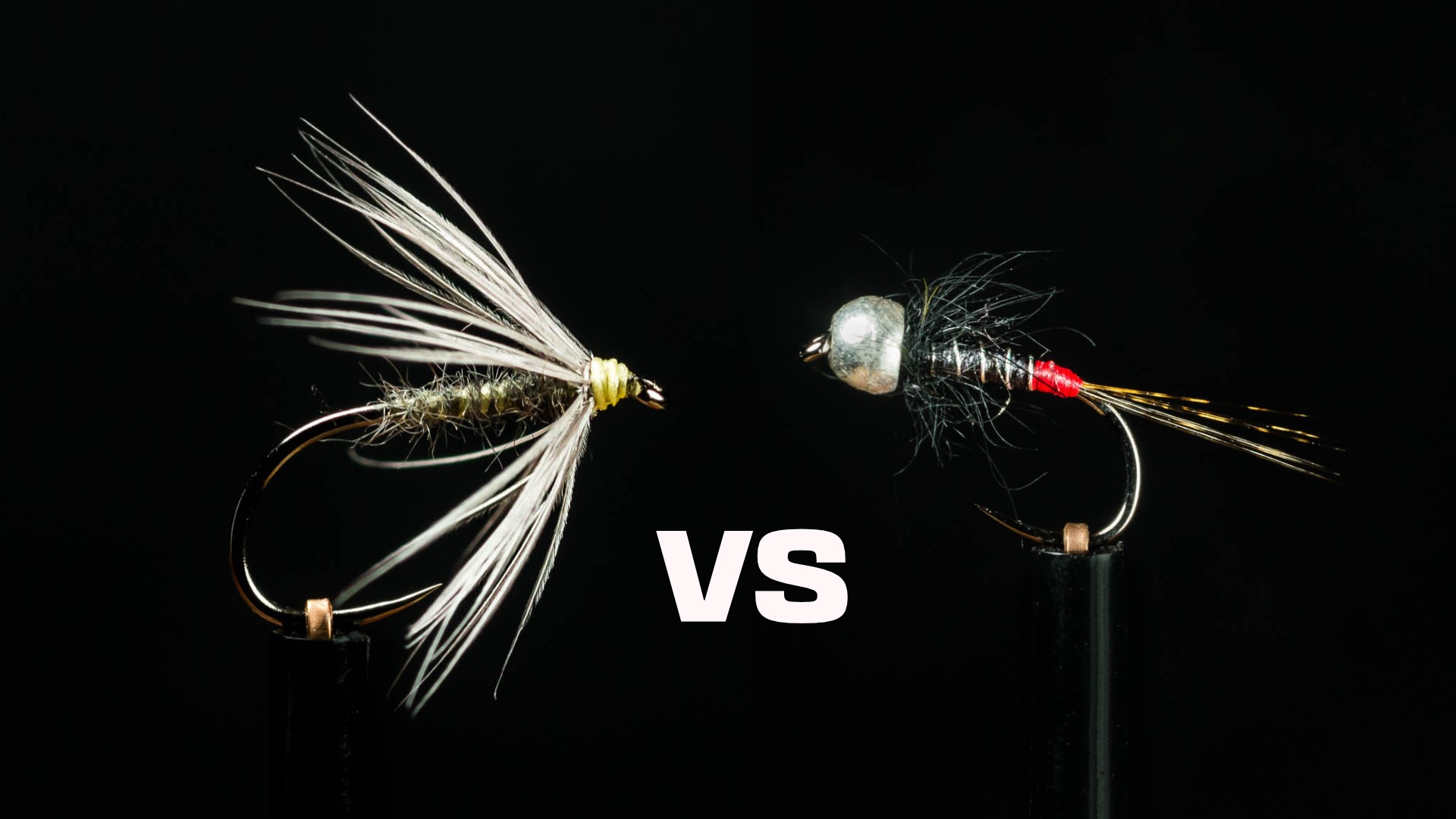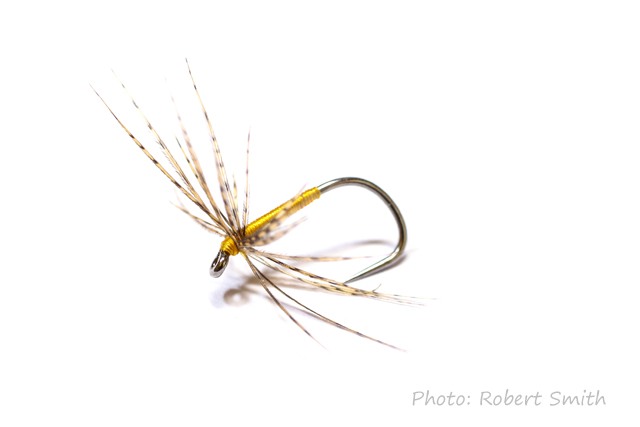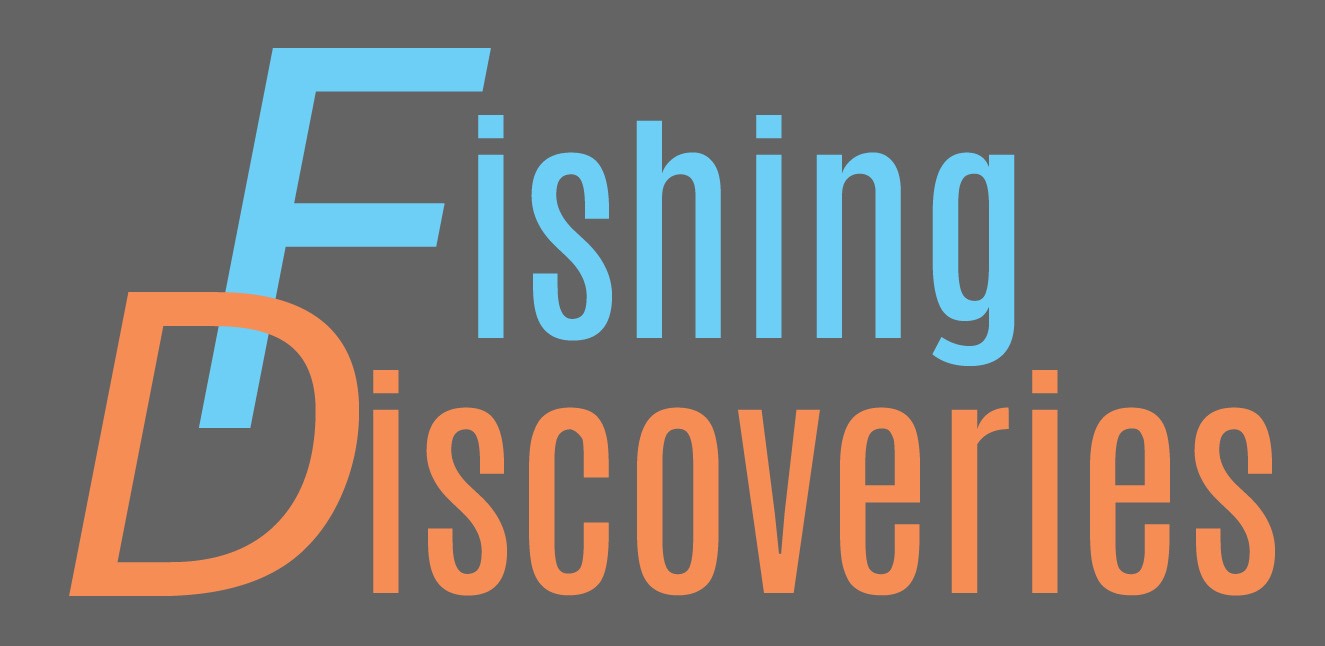
When it comes to a wet flies vs nymphs comparison, this is a bit like the “all oranges are fruit, but not all fruit are oranges” situation. In the strictest fly fishing sense, any subsurface artificial fly can be covered under the umbrella term of “wet flies”. While that, technically, means all nymphs are a kind of wet fly – the two groups remain pretty separate in most anglers’ minds.
Let’s look at some of what makes nymphs different.
Characteristics of Nymphs
As with many things in fly fishing, the boundaries get a bit fuzzy between different “families” of artificial flies. The factors identifying wet flies vs nymphs are no different. With that said, artificial nymphs tend to:

- Be a bit more “grub”, “bug” or “real nymph” like in shape
- Lack traditional, swept-back/feather-slip wings (though not all wet flies have these either, of course)
- Emphasise the thorax area (often with a subtle or even exaggerated bulge and sometimes including wing-case cover imitating features)
- Place less emphasis on collar hackling with game or stiff hackle feathers (with exceptions)
- Commonly incorporate additional weight in their dressing to aid faster sinking (with many exceptions)
Turning to the wet fly side of things…
Characteristics of Wet Flies
This is a necessarily broad category of flies (since it includes every style of sub-surface pattern) – so perhaps it is most useful to concentrate on what many fly fishers picture in their mind’s eye when they hear the term “Wet Fly”. The shape of such flies tends to be associated with the more traditional designs of wet flies from across the ages. However, that image is still useful today since many of the modern wet flies may use updated/synthetic materials while still retaining a lot of those classical proportions and features.

- Wet flies can be winged or wingless. When a wing is included, it tends to be swept back at a relatively shallow angle to the body
- Wet flies almost always have a collar hackle (again, typically – though not always - swept back)
- If a collar hackle is absent, a throat hackle and a wing will usually be present
- The body of a wet fly is typically slim and normally lacks a pronounced thorax bulge
- “Palmered” wet flies have cock hackles wrapped along the length of their bodies – with a ribbing material catching down each turn of hackle stem in the opposite spiral (ideally without trapping any of the feather barbs)
- Spider style wet flies have soft (often game-bird) collar hackles at the head and usually simple thread or lightly dubbed bodies and no tails – and imitate a range of river flies in vulnerable stages of hatching (such as struggling to emerge or otherwise failed/crash landed and drowned)
- Winged wet flies generally have tails and may act as imitations of actively swimming nymphs, small fish or just as general “attractor” patterns without specific imitation in mind
If you have any sort of interest in wet fly patterns, wet fly fishing and how they fit into both traditional and completely modern fly fishing, you'll love this series of exclusive articles:
Wet Flies vs Nymphs: Fishing Methods and Styles
Traditional Stillwater Wet Fly
Both wet flies and nymphs are fished equally commonly in stillwater (lakes, lochs/loughs and reservoirs) as they are in rivers or streams. You can check out my full article on Wet Fly Fishing Techniques to get a good sense of how wet flies are fished on both rivers and stillwaters. Broadly speaking, it is more common to retrieve or strip wet flies in stillwater settings than it is in rivers. Traditional loch/lough-style fishing involves casting teams of three or four wet flies a short distance ahead of a boat that is drifting broadside to the wind.
Short casts with floating fly lines are made and the flies are worked in (and through) the surface layers of the water with the rod tip being raised as the line is retrieved - before lifting off to make the next cast. Modern tactics now include longer casts and fly lines with a whole range of sinking rates.
Traditional River Wet Fly
Although lots of fly fishers are familiar with swinging wet flies down and across the current - it is important to realise how effective dead drifting traditional wet flies (particularly those with soft hackles) at various angles to the current can be. Casting upstream is an excellent method and is one of the core skills of the North Country/Soft Hackle Wet fly tradition of England and Scotland (e.g. Clyde-style). The video below of Robert Smith shows a good example of this in action:
In the same way that there's already a helpful article to explain wet fly tactics, to get a good sense of nymph fishing in rivers, you can check out my guide to Euro Nymphing on rivers.
When it comes to fishing nymphs on stillwaters, this can take quite a variety of different forms. To keep this article on track - and avoid losing focus - I'll split stillwater nymph fishing into 3 broad categories:
- Floating lines and fished static or drifted with a strike indicator
- Floating lines and retrieved (no indicator)
- Sinking lines and retrieved (no indicator)
In all three cases, the critical factor is getting the flies (they are often fished in teams of three) to the eye-level of the fish at their feeding depth. Then it is a case of whether the nymphs are fished relatively statically (e.g. suspended under a strike indicator - with the occasional twitch to induce a strike) or retrieved at anything from a quite constant/steady pace to much faster "pulling" styles of retrieve.
For stillwater nymph fishing, it is hard to over-estimate the importance of non-biting midge or chironomid larvae. Known as "buzzers" by anglers, they are a core element of nymphing in lakes, reservoirs and even lochs/loughs. In those wilder waters, pond olives, mayflies and caddis tend to have been imitated by wet fly approaches over the ages - though nymphing with buzzers is becoming more important as some of those waters become more nutrient-enriched...
Wet Flies vs Nymphs: Which are Most Effective?
Looking at the rafts of social media posts, you'd think modern Euro nymphing on rivers and competition style tactics for small stillwaters and reservoirs had made wet flies redundant. The truth is far from so simple and reminds us that it is rarely wise to say "always" or "never" when it comes to fly fishing.
Yes, it's true that when it comes to situations where cutting through the water and achieving depth quickly and efficiently is important, nymphs can be superior. Such situations include faster/turbulent flow in rivers as well as long-leader buzzer fishing on stillwaters. Their generally slimmer profile (and frequent inclusion of additional weight) is a great advantage in those situations.
BUT - what about situations where lots of the subsurface feeding is concentrating on either drowned, failed emergers, crash-landed adult insects or "spent" egg-laying individuals? There the additional movement and chaotic profile of a hackled wet fly with a more slow-sinking/neutral buoyancy action can far outfish sleeker, hard-profile nymphs.
I remember well-known English river fly fisher and fly tier, Oliver Edwards, giving a talk at my fishing club one evening and saying how the rigid outlines of Czech nymphs had become much less effective on his Yorkshire Dales rivers since their original introduction. He had increasingly turned back towards soft-hackle wet fly patterns to continue fooling fish.
That brings me on to the evolution of hybrid tactics...
Tactical Evolutions - Can We Even Say Wet Flies vs Nymphs Anymore?
Fly Patterns
The tungsten bead changed quite a lot in fly fishing (and it continues to do so). For instance, adding a densely-weighted (possibly custom-colored) bead to the head of a traditional soft-hackle wet fly opens up a lot of possibilities. The same simple thread body and soft collar hackle (a two-material fly!) with the addition of that bead now has mobility, profile and the capacity to reach fishing depth rapidly.
However, is the resultant fly a bead head nymph? That doesn't seem to quite capture it - especially when the original wet fly might have had a peacock herl head (and the associated blunt-faced profile).
Similarly, adding split-thread cdc soft hackles to quill-bodied bead-head nymphs achieves a similar fishing function; but doesn't feel like it changes that nymph into a wet fly.

The crossover doesn't stop with fly tying, it is also present in rigging up...
Wet Flies vs Nymphs Rigs & Tactics
In the cold early spring season when anglers are trying out their traditional wet fly tactics on rain fed rivers in the hope of an early olive mayfly hatch, you now have the option of tying a bead head pheasant tail nymph (for instance) on the point-fly position - to sit the rig down in the cold water; while arming two droppers with traditional soft hackle wet flies.
Similarly, to get over the suspicious rigid/lifeless profile of some nymphs (particularly in slower water), you now have the option of adding a traditional wet fly in between two weighted nymphs, fished on modern Euro nymphing leader setups.
Nearly the exact same principle can be used on buzzer fishing rigs, where the modern nymphs are used to set the depth - then one or more of the droppers can carry a slim, mobile-hackled wet fly pattern for extra life and attraction.
When you then start to mix and match those hybrid tactics with the hybrid fly patterns - you quickly open up a lot of highly effective and adaptable approaches. Perhaps the continuing blurring of the fly patterns and tactics might soon make the question of wet flies vs nymphs redundant? While I don't imagine we'll start calling everything a wet fly (the different sub-categories are too useful when describing specific tactics); it would be good for us to be more comfortable with sliding easily between the different functional applications of different flies and rigs.
That way we can understand the effect we want to create - and then work backwards to construct the best rig and mix of functional flies to meet that goal.
Paul
